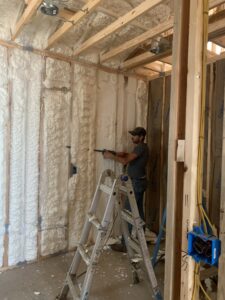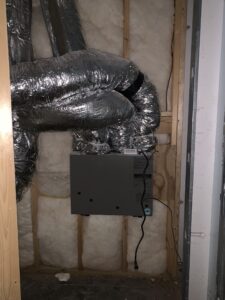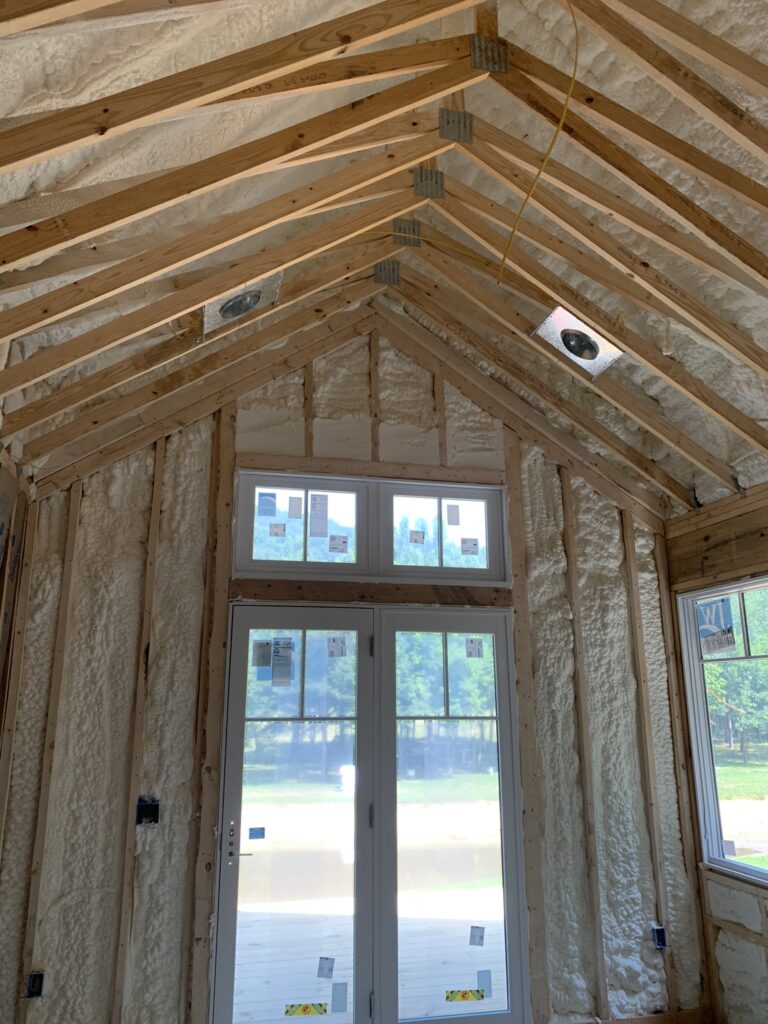Our objective at the outset was to build a solid, energy efficient and comfortable home. Insulation and a tight envelope play a critical role in bringing this about.
Given our desire for an exceptionally tight envelope, spray foam was an obvious choice. It is more costly than fiberglass batt, but only by roughly 25 percent. We sprayed under the roof, all exterior walls and along the rim joyce and sill plate. Doing so both insulated and significantly reduced air flow into the house envelope.

To ensure air tightness, we performed a blower door test after insulation and before drywall. This involves placing a blower over the front door , drawing a vacuum inside the house and measuring the rate of air flow. The first test measured 2,000 cfm with a pressure difference of 50 pascals – about twice what we specified.
With the blower running, we walked throughout the house with caulk guns looking for air leaks. There were many! All were small, such as cracks in between two wooden studs or around doors and windows that had small gaps int he foam sealant. We also found a small gap in the spray foam under the rood decking. Once we couldn’t find any more leaks, we re-tested. Our efforts cut total air leakage to less than 500 cfm. This corresponds to a total surface area of just 1/4 square foot. For perspective, this is tighter than two-thirds of homes in Canada and probably 95% of US homes.
Fresh Air
Most homes don’t have or need mechanical fresh air systems. That’s because fresh air leaks in through hundreds of small gaps throughout the house. But, if you build an exceptionally tight envelope as we did, you have to ensure you get adequate fresh air inside the home or it becomes uncomfortable and unhealthy.
There are several ways to do this. The simplest is to tap into the cold air return of the heat pump and duct to a small vent to the outside. Then, whenever the system runs, some fresh air is sucked into the house. A slightly more advanced approach has a damper on this tap to regulate the amount of fresh air that enters the home and close the fresh air intake when the weather is exceptionally cold outside. The obvious downside of this approach is taking in hot, humid and pollen-filled air in the summer and cold air in the winter.
The most sophisticated approach uses a separate series of ducts which bring in fresh air to bedrooms and common areas, while taking stale air out of the kitchen and bathrooms. This requires extra ductwork and a separate way to move the air.
We chose the simple approach – with a twist. We installed an energy recovery ventilator (ERV). The ERV uses the stale exhaust air to warm (or cool, depending on the season) the incoming fresh air. This saves energy and filters & dehumidifies incoming air. Here is what it looks like in the basement.

